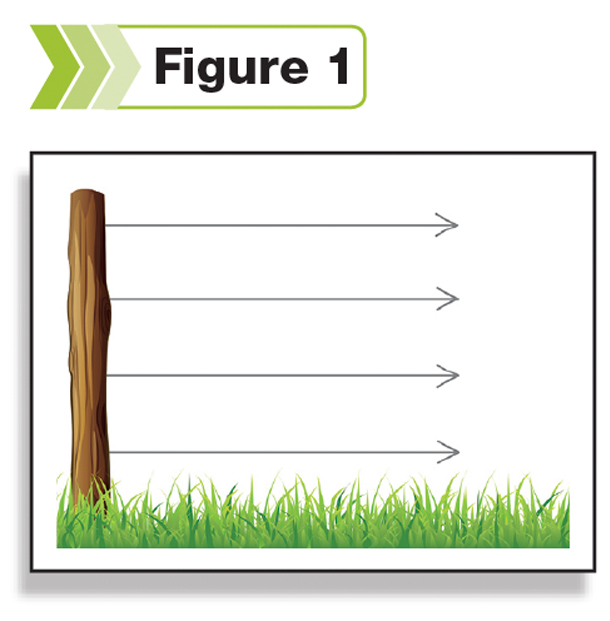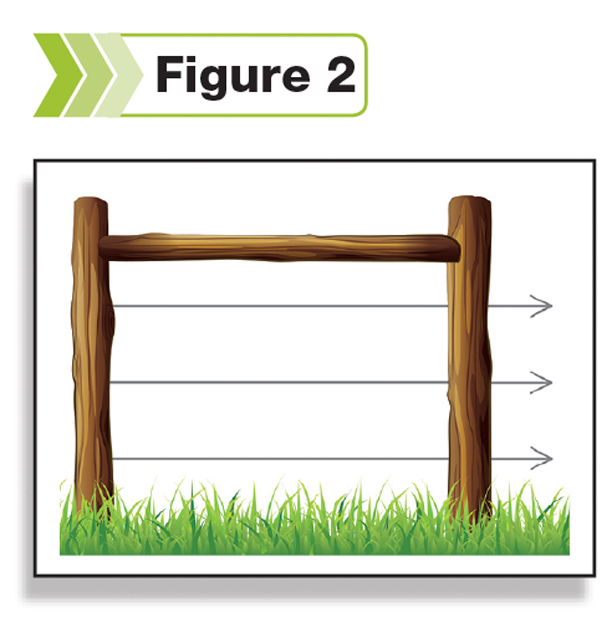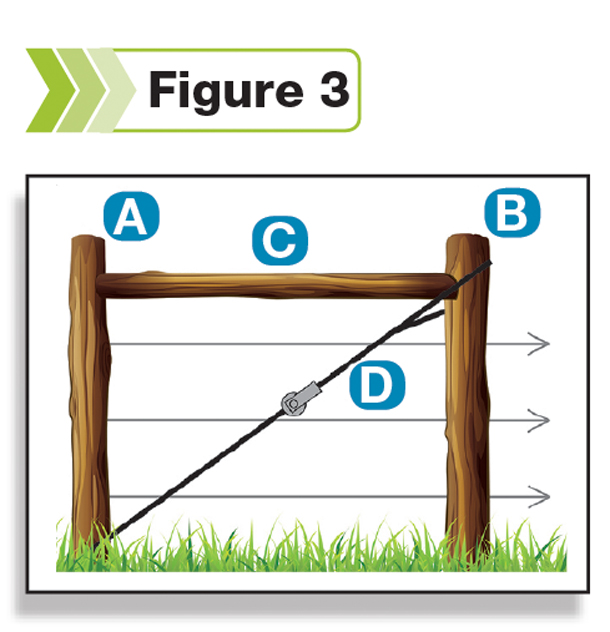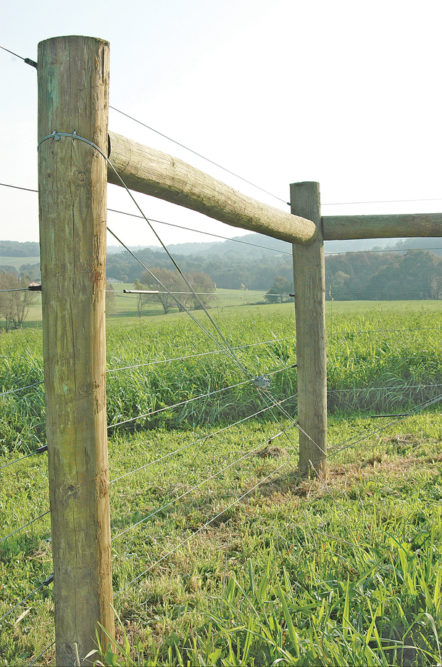You have likely heard a story about a time your friend was tightening the fence wire, and the corner post either came out of the ground or leaned over. This is preventable with a well-constructed corner- or end-post system.
Whether you think of your corner posts as the backbone or cornerstone of your fence, a proper corner-post construction is as important to your fence as a good house foundation is to a long-lasting house.
You have probably seen several variations in corner-post design, such as the H-brace, N-brace, knee brace, N-brace and H-braces side by side, two H-braces side by side or a floating brace (variation of the N-brace).
Today, we’ll focus on the single H-brace corner or end post, since it’s not only a common design but easy to construct, strong and long-lasting.
Getting started
Have you ever wondered how the H-brace works? In Figure 1, let’s assume you only have a single wood post for your fence corner or end. We are not recommending single corner posts for a tensioned wire fence, but it’s our starting point for this discussion.
As shown in Figure 1, let’s assume there is a great distance of tensioned wire fence to the right that is connected to this single corner post.

The tensioned wire naturally wants to pull the top of the corner post to the right, pulling the post over. Let’s improve this single corner post.
Step 1
The first improvement that can be made is to bury the post further into the ground. This will help the post withstand a higher tension.
Depending upon soil type, soil moisture and wire tension, your corner or end post will need to be 3 to 5 feet in the ground. Additional depth enables the post to withstand more force.
Step 2
The second improvement will be to use a larger-diameter post for the corner post. Unless you are using unnecessarily large-diameter line posts, your corner or end post should be 150 to 200 percent more than the diameter of your line posts – a minimum of 5 inches in diameter.
Step 3
The third improvement is to add another post in the ground to share some of the fence wire force pulling on the corner post. You can accomplish this by adding another vertical post (brace post) in the direction of the fenceline and connecting it to the corner post with a horizontal brace or post.
When the left corner post is pulled to the right by the tensioned wires, it pushes on the brace post through the horizontal post. At least now the two vertical posts share the force (but not equally), so this does reduce the amount of force on the corner post.
Figure 2 shows your third improvement over a single corner post: Add a brace post and horizontal post. As you noticed, these three posts resemble the letter “H” (H-brace).

Step 4
For even a medium-tensioned wire fence to last many years, it’s essential to add one final improvement. You need some way to pull the two vertical posts back to the left to counter the force of the tensioned fence wires pulling the posts to the right (in the direction of the rest of the fenceline).
The fourth improvement is to connect a brace wire to the top of the brace (right) post and the bottom of the corner (left) post and tighten it to counter the fence wires pulling the two posts to the right.
Important note: If the brace wire is put on the opposite (wrong) way with the top of the brace wire on the corner (left) post and bottom of the brace wire on the brace post, it makes this three-post H-structure weaker. And since it is now pulling the corner post in the exact same direction that the fence wires are pulling it, the force on the corner post is increased.
From Figure 3, we can now define our corner- or end-post H-brace system with its four components: corner post (A), horizontal post (C), brace post (B) and brace wire (D).

Next, let’s discuss a few additional aspects of the individual parts of your H-brace corner-post system.
Additional tips
-
Corner (A) and brace post (B) – Let’s say your line posts are a 4-inch-diameter wood post. The corner and brace post should be 6 inches in diameter since they take all of the tension; a larger-diameter post is better if you have access to one.
Remember, the more tension on your fence, the larger diameter you want the corner and brace post. Your corner and brace post will be at the same depth (preferably 4 feet deep). If in sandy soil, peat soil or persistently very wet soil, you need a longer corner and brace post, so it’s set deeper than 4 feet.
-
Horizontal post (C) – As a rule of thumb, the horizontal post length should be at least two times the height of the corner post. For example, if your corner post is 4 feet above ground, then use an 8-foot-long horizontal post.
This post should be 4 inches in diameter (or larger). In general, don’t use a horizontal post less than 8 feet long. A shorter horizontal post reduces your brace wire’s counter force. Place the horizontal post where it doesn’t interfere with your fence wires.
This horizontal post should be secured toward the top of the corner and brace post – three-quarters or more toward the top but at least 6 inches down from the top.
-
Brace wire (D) – You may use a twitch board to twist (and tighten) the brace wire for barbed wire or field fence. If using high-tensile smooth wire, it’s best to use an in-line strainer on your brace wire.
The brace wire will be strung around the bottom of the corner post (through staples) and top of the brace post (between the horizontal brace pin and a staple) two times. If you are using 12.5-gauge high-tensile wire, then use the same for your brace wire so an additional-size wire isn’t needed.
Finally, if you have six or more high-tensile wires, you may need two H-braces side by side for additional corner or end post strength. Though there are variations on the details of building the H-brace, the main components remain the same.
Just remember, the corner post is the backbone of your fence; doing this portion correctly will save you time and money down the road.








